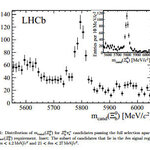Physics

Yesterday I worked from scratch at a problem which certainly others have already solved in the past. I have mixed feelings with such situations: on one side I hate to reinvent the wheel, especially if there is an easy way to access a good solution; on the other I love to invent new ones...
Anyway this time I have decided I will ask you for some help, as collectively we may have a better idea of the optimal solution to the specific problem I am trying to address. But before I explain the problem, let me give you some background on the general context.
Searches for new physics at the LHC
We are…

In metals like copper and aluminium, conduction electrons move around freely, in the same way as particles in a gas or a liquid.
But when impurities are introduced into the metal's crystal lattice, electrons cluster together in a uniform pattern around the point of interference, resembling the ripples that occur when a stone is thrown into a pool of water. Scientists have now discovered how to strengthen these Friedel oscillations and focus them, almost like using a lens, in different directions.
They've discovered (Nature Communications, DOI: 10.1038/ncomms6558) that at a range of 50…

I submitted an article with simple calculations where the "short-distance physics" is integrated out automatically rather than "manually". http://arxiv.org/abs/1409.8326
Happy reading!
Abstract:
I consider a special atomic scattering problem where the target atom has
distinct “soft” and “hard” excitation modes. I demonstrate that in this
problem the integration out of “short-distance” (or “high-energy”)
physics may occur automatically in the regular perturbative
calculations, i.e., it may occur without any cut off and
renormalization. Not only that, the soft inelastic processes happen…

A week ago I offered readers of this blog to review a paper I had just written, as its publication process did not include any form of screening (as opposed to what is customary for articles in particle physics, which receive multiple review stages). That's not the first time for me: in the past I did the same with other articles, and usually I received good feedback. So I knew this could work.This time, however, the response has exceeded my expectations. Besides a few shorter messages pointing at single typos or the like, I received four full reviews, all good and quite useful. The reviewers…

I have been given the privilege of publishing during the Beta test period in the Open Access journal The Winnower for no cost but my time and care. I was also given assistance by the International Journal of Astronomy and Astrophysics to publish my work on massive star formation there. A work unrelated to the first two, on the LCDM model is in press at ScienceOpen Research. All of these are Open Access Journals. Two have open peer review and all have post publication commenting.Here are some good reasons that serious researchers at any career stage should…

Bringing the concept of peer review to another dimension, I am offering you to read a review article I just wrote. You are invited to contribute to its review by suggesting improvements, corrections, changes or amendments to the text. I sort of need some scrutiny of this paper since it is not a report of CMS results -and thus I have not been forced by submit it for internal review to my collaboration.The paper (pdf, postscript, pdf with line numbers) titled "Extraordinary Claims: the 0.000027% Solution", is a review of the history of the 5-sigma criterion in particle physics and a…

The LHCb experiment collaborators at the Large Hadron Collider have announced discovery of two new particles in the baryon family.
The particles, known as the Xi_b'- and Xi_b*-, were predicted to exist by the quark model but had never been seen before. A related particle, the Xi_b*0, was found by the CMS experiment at CERN in 2012.
Like the well-known protons that the LHC accelerates, the new particles are baryons made from three quarks bound together by the strong force. The types of quarks are different, though: the new X_ib particles both contain one beauty (b), one strange (s…

A whirlpool of hybrid light-matter particles called polaritons has been created using a spiral laser beam.
Polaritons are hybrid particles that have properties of both matter and light. The ability to control polariton flows in this way could aid the development of completely novel technology to link conventional electronics with new laser and fibre-based technologies.
Polaritons form in semiconductors when laser light interacts with electrons and holes (positively charged vacancies) so strongly that it is no longer possible to distinguish light from matter.
The team created the spiral beam…
When two
giant LIGO detectors
are switched on in the US next year, they will help scientists pick up the faint ripples of black hole collisions millions of years ago, known as gravitational waves.
Black holes cannot be seen, but scientists hope the revamped detectors, which act like giant microphones, will find remnants of black hole collisions - and theoretical physicists hope experimentalists will give validation for their numerical model.
The new model has been programmed into the computer codes that LIGO scientists all over the world are preparing to use to search for black-…

I am quite happy to report today that the CMS experiment at the CERN Large Hadron Collider has just published a new search which fills a gap in studies of extended Higgs boson sectors. It is a search for the decay of the A boson into Zh pairs, where the Z in turn decays to an electron-positron or a muon-antimuon pair, and the h is assumed to be the 125 GeV Higgs and is sought for in its decay to b-quark pairs.
If you are short of time, this is the bottomline: no A boson is found in Run 1 CMS data, and limits are set in the parameter space of the relevant theories. But if you have a…